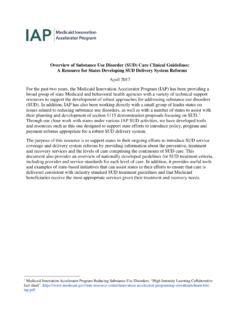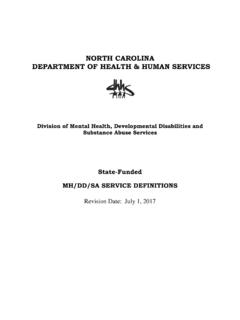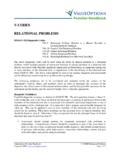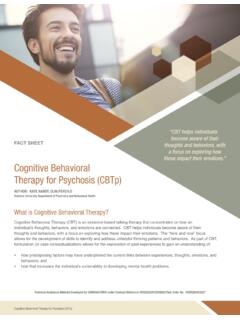Transcription of CDC Promotes Public Health Approach to Address Depression ...
1 1 For More Information At CDC Healthy Aging Program: At Health Benefits ABCs: William F. Benson, 202-255-2001 CDC Promotes Public Health Approach To Address Depression among Older Adults Did you 20 percent of adults age 55 and older have a mental Health disorder (such as anxiety, cognitive impairment, or mood disorder) that is not part of normal aging (American Association for Geriatric Psychiatry, 2008). 15 20 percent of adults older than age 65 in the United States have experienced Depression (Geriatric Mental Health Foundation, 2008). 7 million adults aged 65 years and older are affected by Depression (Steinman, 2007). Chronically ill Medicare beneficiaries with accompanying Depression have significantly higher Health care costs than those with chronic diseases alone (Un tzer, 2009). People with serious mental illness are more likely to die on average at age 51 from complications of unhealthy risk factors (such as smoking or obesity), compared with age 76 for all Americans (Parks, 2006).
2 People aged 65 years and older accounted for 16 percent of suicide deaths in 2004 (Centers for Disease Control and Prevention, 2007). I didn t know anything about Depression , so I didn t know I was depressed.. The questionnaire was essential to getting me in for treatment. It was sent to me three times before I sent it back. I took medication and went to a class that helped me learn skills to work on the Depression .. I now have two friends getting treatment for Depression since I told them about my situation. Participant in a Depression care management program (CDC, 2009a) An estimated 7 million of the nation s 39 million adults aged 65 years and older are affected by Depression , which is a persistent sad, anxious, or empty feeling, or a feeling of hopelessness and pessimism. Depression in older adults is often not recognized or treated. Yet, it is fairly easy to detect, highly treatable, and a candidate for prevention efforts making it an excellent focus for Public Health activities.
3 Depression is not a normal part of aging. While older adults may face widowhood, loss of function, or loss of independence, persistent bereavement or serious Depression is not normal and should be treated ( Surgeon General, 1999). Living with untreated Depression presents a serious Public Health problem. Depression complicates chronic conditions such as heart disease, diabetes, and stroke; increases Health care costs; and often accompanies functional 2 impairment and disability (Frederick, 2007; Katon, 2003; Snowden, 2008; Un tzer, 1997). Depression is also linked to higher Health care costs (Un tzer, 1997) and tied to higher mortality from suicide and cardiac disease (Frederick, 2007; Snowden, 2009). Effective treatment reduces depressive symptoms and secondary symptoms such as pain, and improves functioning and quality of life (Frederick, 2007; Snowden, 2008). That means Depression among older adults can be addressed through better community-based approaches to identifying and treating Depression and through more Public awareness.
4 This issue brief will examine community-based approaches to Depression and the role of Public Health and the aging services network. Public Health ROLE The nation is now poised to take the next step toward realizing the vision of integrating mental Health and Public Health described a decade ago in the Surgeon General s report. Spiraling Health care costs and the rising number of uninsured Americans have built momentum for Health care reform, and it is clear that a population-based, Public Health Approach one that encompasses mental Health will be needed as a foundation for that reform. David Satcher, , , Morehouse School of Medicine and former surgeon general As the lead government agency for the nation s Public Health , the Centers for Disease Control and Prevention (CDC) plays a central role in the efforts to integrate mental Health and Public Health (Satcher, 2010). CDC s Healthy Aging Program also has been working to link Public Health departments with the aging services network on mental Health issues.
5 CDC s role in mental Health of the aging includes collecting data to monitor the effect of Depression on older adults, helping states assess their state and local data, gathering evidence for effective community-based programs, and promoting evidence-based interventions that can help adults maintain a healthy outlook. The Public Health community can monitor Depression in the population; develop, test, and start programs that Address Depression in older adults; and incorporate mental Health promotion into chronic disease prevention efforts. In addition, the Public Health community can work with aging services and mental Health providers to more readily reach older adults who may be depressed. Routine, systematic screening can successfully identify adults who are depressed and direct them to appropriate treatment, CDC concludes in its report Promoting Preventive Services for Adults 50 64: Community and Clinical Partnerships (CDC, 2009c). 3 CDC collects data on Depression , anxiety, psychological distress, and mental illness stigma through supplemental mental illness symptom modules to the state Behavioral Risk Factor Surveillance System (BRFSS) questionnaire.
6 The BRFSS is the world s largest, ongoing telephone Health survey system, tracking Health conditions and risk behaviors in the United States annually. In 2006, 38 states and three territories used a Depression and anxiety module, according to CDC. The substance abuse and Mental Health Services Administration (SAMHSA) has funded the following number of states to add either the mental illness and stigma module or the Depression and anxiety module to their BRFSS: 36 states in 2006; 35 states in 2007; 19 states in 2008; and 19 states in 2009 (Freeman, 2010). In addition, since 1993 the BRFSS has included a question about number of mentally unhealthy days experienced. Mentally unhealthy days are those when mental Health was not good because of stress, Depression , or emotional problems. Interestingly, a trend toward more mentally unhealthy days has been occurring for people in the 55 64 age group. This preretirement age group reported mentally unhealthy days a month in 2000, rising to days in 2008, the last year for which data is available (CDC, 2009b; Zack, 2004).
7 That is a significant trend, said Rosemarie Kobau, , Public Health advisor in the Arthritis, Epilepsy, and Quality of Life Branch. Comparable numbers for ages 64 74 and 75+ were around mentally unhealthy days a month in those same years. CDC also collects information through the National Health Interview Survey, National Health and Nutrition Examination Surveys, and Medicare Health Outcomes Survey. In addition to CDC, the Surgeon General, the Task Force on Community Preventive Services, Healthy People 2010, the White House Conference on Aging, and other experts have recognized Depression as a significant Public Health problem among older adults. The Surgeon General identified older adults as a priority concern in its first report on mental Health ( Surgeon General, 1999). It concluded there are effective interventions for most mental disorders, such as Depression and anxiety, experienced by older persons and for many mental Health problems, such as bereavement.
8 The Task Force on Community Preventive Services reviewed Depression treatments and recognized several broad categories as appropriate for adults aged 60 years and older (TFCPS, 2007). It strongly recommended home-based Depression care management and clinic-based Depression care management. (See Treating Depression below). Healthy People 2010, the nation s Health promotion and disease prevention initiative, aims to reduce the proportion of adults with disabilities who report feelings such as sadness, unhappiness, or Depression that prevent them from being active (HHS, 2000). 4 The 2005 White House Conference on Aging adopted a resolution to improve recognition, assessment, and treatment of mental illness and Depression among older Americans (WHCOA, 2005). SAMHSA s Transforming Mental Health Care in America initiative included older adults among its target groups for a seamless system designed to help people achieve their maximum potential in all spheres of life and at all points in their development (SAMHSA, 2005).
9 The initiative called for SAMHSA, CDC, and the Health Resources and Services Administration to collaborate in helping to serve older adults. As a result of this attention to the mental Health problems of older adults, the once-separate Public Health and mental Health systems are starting to work more closely together to Address Depression among older adults. In the past, Public Health focused on surveillance for Health behaviors and chronic disease in order to plan Public Health programs, while the mental Health field used a separate data collection system that emphasized measurement of disease prevalence and Health care use (Freeman, 2010). Recent efforts to integrate these systems have included adding chronic disease measures to the Collaborative Psychiatric Epidemiology Surveys and incorporating Depression measures in the BRFSS and other data collection systems (Freeman, 2010). WHAT IS Depression ? Everyone feels sad or blue sometimes. It is a natural part of life.
10 But when the sadness persists and interferes with everyday life, it may be Depression . Depression is not a normal part of growing older. It is a treatable medical illness, much like heart disease or diabetes. Geriatric Mental Health Foundation The Surgeon General in 1999 identified mental Health as a state of successful performance of mental function, resulting in productive activities, fulfilling relationships with other people, and the ability to adapt to change and to cope with adversity. Mental disorders, on the other hand, are characterized by alterations in thinking, mood, or behavior (or some combination thereof) associated with distress and/or impaired functioning. Research indicates depressive illnesses are disorders of the brain (NIMH, 2007). Depression has no known cause, but is believed to result from several genetic, biochemical, environmental, or psychological factors. Depression is treatable in 80 percent of cases (NIMH, 2007).















